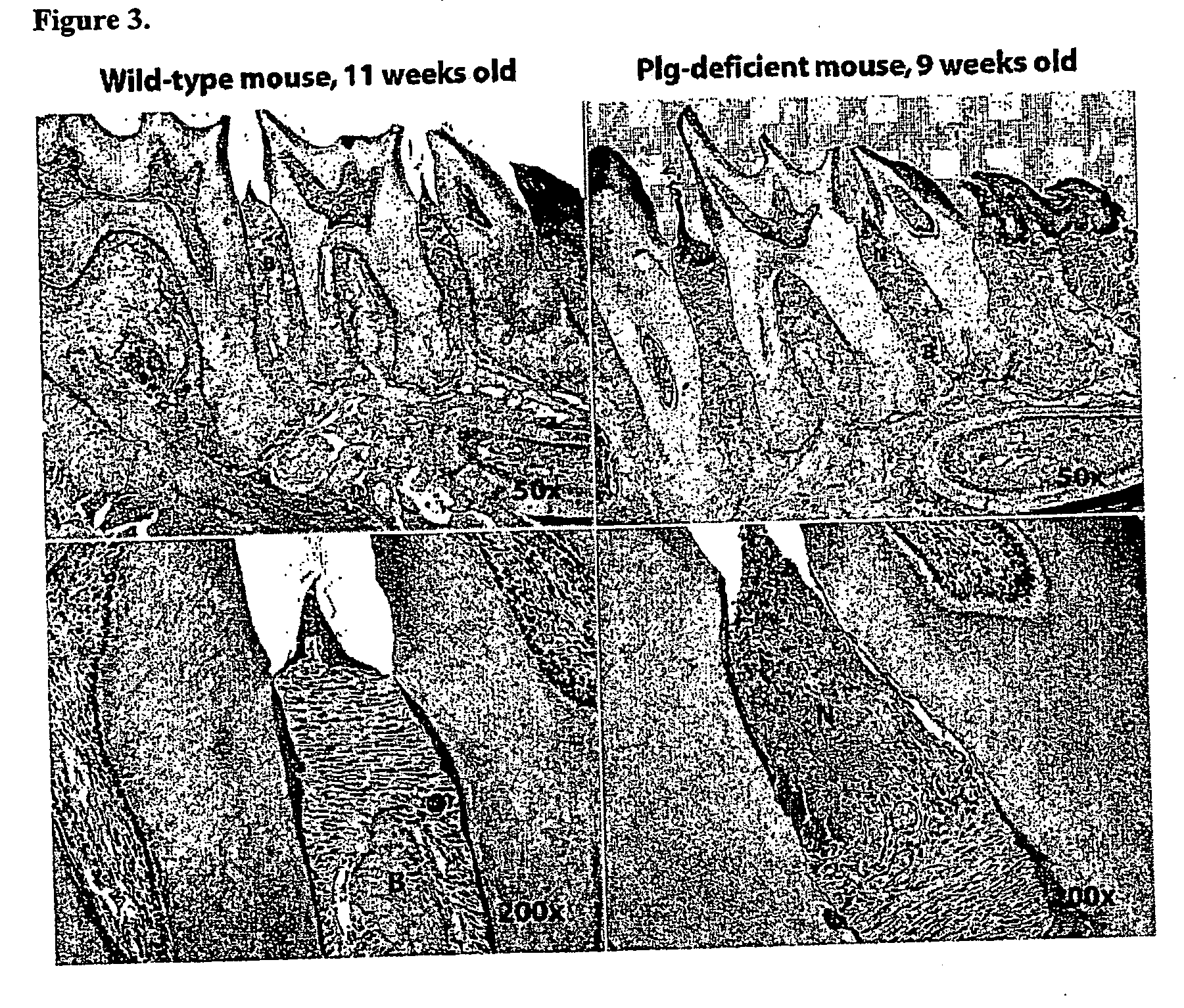Drug target for preventing and treating periodontal disease, improving healing of periodontal wounds and promoting oral health
a periodontal wound and oral health technology, applied in the direction of drug compositions, antibacterial agents, peptide/protein ingredients, etc., can solve the problems of poor oral health, heart disease and stroke, diabetes, and premature delivery, and achieve the effects of promoting oral health, promoting healing of periodontal wounds, and accelerating the migration of keratinocytes
- Summary
- Abstract
- Description
- Claims
- Application Information
AI Technical Summary
Benefits of technology
Problems solved by technology
Method used
Image
Examples
example 1
In Vitro Keratinocyte Migration is Dependent on the Relative Amounts of Plasminogen
[0094]Since wound healing involves a huge number of different factors, cells and processes, a simplified in vitro model is included to delineate the possible plasminogen effect on cell migration.
[0095]Methods:
[0096]DOK (early neoplastic / dysplastic human oral keratinocytes) cells were incubated in cell culture media After starving, DOK cells were incubated in DMEM cell culture medium, containing hydrocortisone, glutamine, penicillin / streptomycin, 10% plasminogen depleted fetal bovine serum, and in the absence or presence of human plasminogen. At 0 h, a standard scratch was made on the keratinocyte layer in order to induce in vitro wound healing model. At different tine points (0 h, 12 h and 24 h) the keratinocyte migration was documented under ZEISS microscope.
[0097]Results:
[0098]DOK (early neoplastic / dysplastic human oral keratinocytes) cell migration seems to be almost arrested in the absence of plas...
example 2
Spontaneous Development of Periodontal Disease in Plasminogen-Deficient Mice
[0099]Methods:
[0100]This experiment is dedicated to investigate the importance of plasminogen in the development of periodontal disease by analyzing wild-type and plasminogen-deficient mice at different age.
[0101]Plasminogen-deficient (plg deficient) and wild-type (wt) mice were divided into three age groups (5-8 mice per genotype per group): Group I: 8-12 weeks old; Group II: 12-16 weeks old; Group III: 16-20 weeks old. The development of periodontal disease was followed by analyzing the tissue samples of each genotype and age group.
[0102]To analyze the tissue samples, the lower and upper jaws are separated from the cranium, de-fleshed from gross soft tissue such as tongue, and fixed in 4% paraformaldehyde (PFA) for 24 hours. Thereafter, samples were transferred to the decalcification solution to remove calcium from the bone tissue. After four weeks of decalcification process specimens were embedded in para...
example 3
Plasminogen-Deficient Mice Have Significantly Higher Amounts of Bacteria in the Saliva Than That of Wild-type Mice
[0105]Methods:
[0106]Wild-type, plasminogen-heterozygous and plasminogen-deficient mice at age between 16-20 weeks old were used in this study (Table 1). Salivary sampling of mice was performed by collecting the saliva from the mouth with a sterile pipette tip and transferred into anaerobic medium for immediate culturing.
[0107]Results:
[0108]5 ul of salivary samples were successfully collected from wild-type and plasminogen-heterozygous mice. However, due to the general dry conditions of the mouths in plasminogen-deficient mice, the amount of possible of salivary samples resulted in variations, ranging from 1.0 ul to 5.0 ul. Bacterial recovery showed that plasminogen-deficient mice have nearly 9.0×106 / ml of bacteria in saliva, the highest in the three groups and significantly higher than that of wild-type mice. Importantly, plasminogen-heterozygous mice also have significa...
PUM
| Property | Measurement | Unit |
|---|---|---|
| molecular mass | aaaaa | aaaaa |
| thickness | aaaaa | aaaaa |
| pharmaceutical composition | aaaaa | aaaaa |
Abstract
Description
Claims
Application Information
 Login to View More
Login to View More - R&D
- Intellectual Property
- Life Sciences
- Materials
- Tech Scout
- Unparalleled Data Quality
- Higher Quality Content
- 60% Fewer Hallucinations
Browse by: Latest US Patents, China's latest patents, Technical Efficacy Thesaurus, Application Domain, Technology Topic, Popular Technical Reports.
© 2025 PatSnap. All rights reserved.Legal|Privacy policy|Modern Slavery Act Transparency Statement|Sitemap|About US| Contact US: help@patsnap.com



